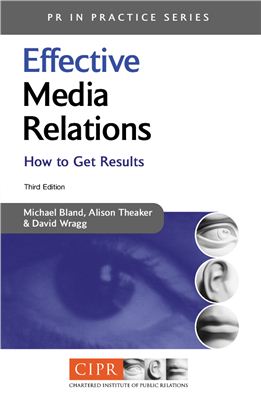Издательство Kogan Page, 2005, -161 pp.
Серия PR in Practice
To the uninformed, public relations is synonymous with press relations and, indeed, many public relations practitioners spend much of their time dealing with the press. Some spend none of their time on media relations. The stories that joualists relate of naive practitioners sending the wrong material to the wrong people are legion. They also frequently, and rightly, complain that press material is badly presented as advertising in disguise and of no interest at all to them or their readers. The advent of the inteet and other new technologies has meant radical change to the way public relations professionals work with joualists, and more is on the way.
The experts writing here provide a practical insight and guide for those wanting to work effectively with the media. In Part One, Alison Theaker deals with the media context. Knowing something about the history of the media, its ownership and how it is regulated and being aware of the rules of slander and libel are absolutely essential. So too is knowledge of the latest developments.
David Wragg then looks at the written press. He outlines the opportunities that are available, explains in detail what sort of approach should be taken and the different types of writing required. He then provides detailed practical hints and tips on how to go about it all.
Rounding off the book, Michael Bland takes a behind-the-scenes look at radio and television interviews. He gives an insight into how these media work and then lays down easy-to-follow guidelines on how to get the most from the interview, while also giving the joualists what they want.
By reading this book, the newcomer to public relations practice will have a very solid basis on which to work, will be able to provide a professional service to the press and will gain the satisfaction
of knowing they have done their job well.
Part 1 The Media Context
Where and when: a brief media history
Who: ownership of the media
Media law
Ethics and privacy
Broadcasting in the UK
New media technology
What is it all for? Media evaluation
Part 2 Dealing with the Press
What: newspapers and periodicals
Why: press relations – a means to an end
News, features and more
How: writing for the press
How: talking to the press
Checklist for effective press relations
Part 3 Handling the Broadcast Media
Why: the importance of broadcast coverage
How: preparation and briefing
How: winning the interview
Fine-tuning: handling different interviews
How: radio interviews
Серия PR in Practice
To the uninformed, public relations is synonymous with press relations and, indeed, many public relations practitioners spend much of their time dealing with the press. Some spend none of their time on media relations. The stories that joualists relate of naive practitioners sending the wrong material to the wrong people are legion. They also frequently, and rightly, complain that press material is badly presented as advertising in disguise and of no interest at all to them or their readers. The advent of the inteet and other new technologies has meant radical change to the way public relations professionals work with joualists, and more is on the way.
The experts writing here provide a practical insight and guide for those wanting to work effectively with the media. In Part One, Alison Theaker deals with the media context. Knowing something about the history of the media, its ownership and how it is regulated and being aware of the rules of slander and libel are absolutely essential. So too is knowledge of the latest developments.
David Wragg then looks at the written press. He outlines the opportunities that are available, explains in detail what sort of approach should be taken and the different types of writing required. He then provides detailed practical hints and tips on how to go about it all.
Rounding off the book, Michael Bland takes a behind-the-scenes look at radio and television interviews. He gives an insight into how these media work and then lays down easy-to-follow guidelines on how to get the most from the interview, while also giving the joualists what they want.
By reading this book, the newcomer to public relations practice will have a very solid basis on which to work, will be able to provide a professional service to the press and will gain the satisfaction
of knowing they have done their job well.
Part 1 The Media Context
Where and when: a brief media history
Who: ownership of the media
Media law
Ethics and privacy
Broadcasting in the UK
New media technology
What is it all for? Media evaluation
Part 2 Dealing with the Press
What: newspapers and periodicals
Why: press relations – a means to an end
News, features and more
How: writing for the press
How: talking to the press
Checklist for effective press relations
Part 3 Handling the Broadcast Media
Why: the importance of broadcast coverage
How: preparation and briefing
How: winning the interview
Fine-tuning: handling different interviews
How: radio interviews

